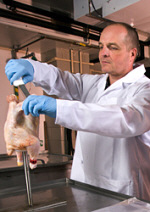



Chilling Chicken: Immersion or Dry-Air?
US - Chilling is an important step in processing poultry carcasses before marketing of the birds, and there are different ways to do it. Agricultural Research Service (ARS) scientists at the Richard B. Russell Research Center in Athens, Ga., recently compared two chilling methods to determine which better suits processors' needs.Food technologist Julie Northcutt, formerly with the ARS Poultry Processing and Swine Physiology Research Unit at Athens, and food technologist Doug Smith, in the ARS Quality and Safety Assessment Research Unit at Athens, evaluated the two primary industry methods in terms of meat quality, food safety and water management.
 |
| ARS food technologist Doug Smith tests whether wet immersion or dry air chilling is more effective in controlling bacterial pathogens on chicken. |
Carcass temperatures must be quickly lowered after poultry slaughter to prevent growth of bacterial pathogens that may cause food-borne illness when consumed. Immersion chilling--in which chicken carcasses are submerged in tanks of cold water or an ice-and-water mix--is the predominant method now used in the United States. Dry-air chilling blasts carcasses with cold air, while evaporative-air chilling combines cold air blasts with water misting. Some poultry processors are beginning to convert to dry-air chilling.
Both immersion chilling and air chilling met criteria for limiting bacterial pathogen growth on carcasses. But tender chicken is also very important to consumers. During commercial processing, whole carcasses are aged under refrigerated conditions to allow muscle fibers to relax and become tender. Research showed that air chilling led to better quality of breast fillets and provided higher cooked-meat yields than immersion chilling.
In the end, water may be the most important factor in deciding which chilling method may be most feasible in the future. It takes an average of seven gallons of water to process each chicken, and switching to air chilling can save a minimum of one-half gallon per bird. Processors could save about 4.5 billion gallons of water per year if all 9 billion birds processed annually in the United States were air-chilled.








